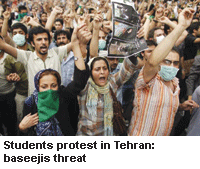In the autumn of 1978 the beleaguered Shah postponed the autumnal return of Iran’s politically disgruntled students to their universities by several months. But when the institutions of learning eventually opened their doors, the students soon poured furiously into the streets in their tens of thousands, until, in the growing mayhem, the Shah fled and Ayatollah Ruhollah Khomeini replaced him. Could the same process occur all over again?
 Today’s authorities are loath to take any risk. Iran’s students are still seething with discontent following the disputed presidential elections of June 12. And the government sounds reluctant to reopen universities on their due date (September 23). But it also wants to show that everything is back to normal after the turmoil of the two months that followed the election.
Today’s authorities are loath to take any risk. Iran’s students are still seething with discontent following the disputed presidential elections of June 12. And the government sounds reluctant to reopen universities on their due date (September 23). But it also wants to show that everything is back to normal after the turmoil of the two months that followed the election.
Therefore the authorities are already preparing to take countermeasures in case students revolt again. At a recent Friday prayer, the quiet streets around Tehran University became rallying points for clusters of conservative worshippers, many of them wearing the characteristic untucked shirts of the vast paramilitary organisation known as the baseej, which has carried out much of the thuggery against opponents of Mahmoud Ahmadinejad, who was reinstalled as president in August. Many of Tehran’s students were prevented from taking their final examinations because of the disturbances in the election’s immediate aftermath. Now the baseejis are on the alert in case, when the students do return at the end of September, they take their chances once more to express their disaffection in public.
In any event, the Supreme Cultural Revolution Council, the government body that oversees education, stated at the end of August that universities may shut in the autumn because of swine flu, just as officials had cited high pollution levels as the reason for keeping students indoors after the summer election.
In some universities the authorities have delayed registration of students for the new academic year. In Shiraz, where campuses have already reopened, security forces are tightly controlling them, with circulars telling students not to undertake unauthorised political activities. Elsewhere, even if universities do reopen, classrooms may be packed with loyal baseejis, who may get increased quotas.
Students who have gone back say they are afraid that masked baseejis may beat them up if they step out of line. This happened in mid-June when Tehran University’s dormitories were stormed at midnight in a raid now being investigated on the orders of Ayatollah Sadeq Larijani, a tough disciplinarian and the new head of the justice system. “The regime can’t control students easily,” says a Tehran graduate. “The only way to keep them calm is to threaten them with an attack by the baseej”.
Iran’s supreme leader, Ayatollah Ali Khamenei, seems rattled by the prospect of student unrest and has hinted that the regime may purge universities of professors suspected of “unIslamic” tendencies. On August 30 he complained that the study of social science “promotes doubts and uncertainty”, telling a meeting of students and teachers that the study of liberal arts and other humanities had led to a “loss of belief in godly and Islamic knowledge”. Perhaps presaging a crackdown on teachers as well as students, Kamran Daneshjou, who ran the interior ministry’s election headquarters during the presidential poll, has been appointed minister in charge of universities.
Yet the regime is unlikely to close the universities altogether. When the students return it may become clearer whether the students can pep up an opposition that may, in the past months or so, have begun to flag. In any event, internecine skirmishing within the ruling establishment is still going on — ensuring that Iran’s crisis is far from over.
(Excerpted and adapted from Times Higher Education)